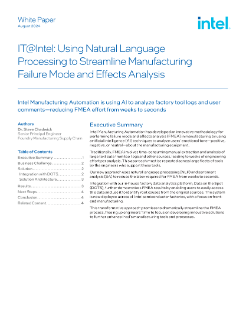Using Natural Language Processing to Streamline Manufacturing Failure Mode and Effects Analysis
Learn how Intel’s manufacturing engineers are using natural language processing (NLP) to streamline failure mode and effects analysis (FMEA).
Intel Manufacturing Automation has developed an innovative methodology for performing FMEA in manufacturing by using artificial intelligence (AI) techniques to analyze users’ emotional tone—positive, negative, or neutral—about the manufacturing equipment.
Failure mode and effects analysis (FMEA) is a critical process in manufacturing that is used to identify potential failures, assess their impact, and prioritize preventive actions. The FMEA process involves breaking down the system into its individual components; analyzing each component for potential failure modes; determining the effects of these failures; and assigning a risk priority number based on severity, occurrence, and detectability.
Traditionally, FMEA involves time-consuming manual extraction and analysis of large text data from tool logs and other sources, leading to weeks of engineering effort per analysis. This approach must be repeated across large fleets of tools by the engineers who support these tools.
Our new approach uses natural language processing (NLP) and sentiment analysis (SA) to reduce the labor required for FMEA from weeks to seconds. When we compared the traditional FMEA approach to our SA-based system, the software discovered everything the engineers found with their manual system approach—plus even more that they missed. Our system performed FMEA on six months’ worth of data in under one minute, saving weeks of engineering time.
Our SA analysis extracts keywords from comments, notes, charts, and quality systems data to find words with negative connotations about a tool, such as “abort” or “fail.” We’ve customized the analysis for domain-specific language, such as words and phrases that are specific to the semiconductor fab environment (e.g., “defect” and “excursion”). We also implemented custom replacement keywords (“ABORT” vs. “ABT” vs. “ABRT”) to accommodate various abbreviations and spelling errors commonly found in tool logs and other data sources.
The system analyzes sentence structure and filters out brackets for HTML and other special characters used in programming languages, allowing for a wide variety of inputs. While Intel’s manufacturing logs are predominantly in English, the libraries can be extended to handle multilingual input.
Integration with our in-house factory data analytics platform, Data on the Spot (DOTS), further democratizes FMEA results by enabling users to easily access this data and use it to identify root causes from the original sources. The system is now deployed across all Intel semiconductor factories, with a focus on front-end manufacturing.
The Intel® architecture-based components of our new FMEA system enable us to deploy new features rapidly. The FMEA system is powered by Intel® Xeon® processors, which provide the computational power and performance needed for real-time analysis of large datasets. The system uses high-speed SSDs and advanced memory configurations to ensure rapid data access and processing. Fast Intel® Optane™ persistent memory is employed to enhance caching capabilities and accelerate data retrieval.
This transformative approach promises to dramatically streamline the FMEA process, freeing up engineers’ time to focus on developing innovative solutions to further enhance Intel’s manufacturing tools and processes.
